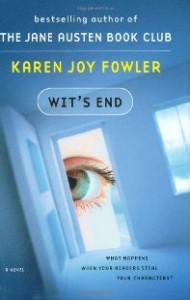The beginning: A woman called Rima, the last surviving member of her family, comes to live with her godmother, a famous mystery writer, in Santa Cruz. Addison was estranged from Rima’s father years ago, for reasons Rima has never known, and Rima has come to Santa Cruz partly to find out whether there was anything more than friendship between her father and her godmother. While living at Addison’s mansion (called Wit’s End), Rima becomes fascinated by Addison’s fans, whose online presence has given Addison’s fictional detective a life of his own.
Damn, Wit’s End (affiliate links: Amazon, B&N, Book Depository) is hard to describe. Hard to describe, but good!
The end (spoilers in this section only, so skip down to “the whole” if you don’t want to know): Here are a bunch of characters whose names I do not recognize, but never mind. The major mystery is solved — Addison and Rima’s father Bim became estranged because Addison (inadvertently, but Bim thought it was on purpose) put into her book a true story of how Bim brought about someone else’s murder at the hands of a cult leader. Oh, that’s sad. There are a few other things solved too, that I didn’t think to wonder about, like that Addison turns out to have been the daughter of (real live) cult leader William E. Riker. I enjoy Karen Joy Fowler’s extremely weird blending of fact and fiction.
The whole: I enjoy Karen Joy Fowler’s extremely weird blending of fact and fiction. (I said that a second ago but maybe you missed it because you weren’t reading the spoilers section.) If you aren’t already obsessed with cults — which going from her short stories and novels, Karen Joy Fowler is — you may not know that the Holy City is a real place, and William E. Riker was a real person, and the mysterious fires that destroyed Holy City buildings after it was sold were real fires and probably arsons. And if Karen Joy Fowler hadn’t thanked the owner of Holy City Art Glass in the acknowledgements, I wouldn’t have known any of that was real. It makes the book even more intriguing, as it’s a book about a fictional book that fictionalizes the cult and its history.
I’ve said recently on the podcast that I like the depiction in books of miscommunications between characters, and Wit’s End is full of these. Although the book is from Rima’s point of view, Fowler regularly tosses in remarks about what Rima thinks is being said or intended versus what really is being sad or intended. For instance:
“Martin’s always welcome.” Addison glanced at Rima.
Here is what the glance meant: Don’t worry. No way will Martin stay the night. Here’s what Rima thought it meant: I know I said you’d have the whole floor to yourself, and now I’m sorry I said so. …
“You’ll like Martin,” Tilda told Rima, and from the darkness behind Tilda’s shoulder, Addison gave Rima another look, hard and right at her.
This look meant: Martin’s a conniving little snot. Here’s what Rima thought it meant: I know I said you’d have the whole floor to yourself, and now I’m sorry I said so.
Lovely, right? As in We Are All Completely Beside Ourselves, Fowler is fantastic at depicting the space between people, both the closeness and the inescapable separateness. The book begins with Rima having all the questions and Addison (presumably) all the answers, and it ends the other way around, with Rima understanding what Addison never has, and explaining to her the parts of it that won’t cause unnecessary pain. They are not brought closer by any of this; they are only brought closer by proximity and the shared desire for affection.
Fowler’s gift for weird, specific detail, which in her short fiction can feel like a build-up to a cymbal crash that never comes, serves her well in Wit’s End. The truth of Holy City, California mixes in seamlessly with the imagined world of Addison’s books. Addison’s home, the setting for the whole story, was formerly a bed-and-breakfast and before that belonged to a woman who survived the Donner Party. Addison’s mystery novels are created on the basis of intricate dollhouses representing the crime scenes, which Addison makes in exquisite detail prior to writing the book — a detail clearly based on the Nutshell Studies of Unexplained Death, a series of model crime scenes created in the mid-1900s by an heiress that continue to be used to train police officers in forensics. These are the kind of weird yet lifelike details that make me so fond of Karen Joy Fowler (she’s a magpie like me).
So: Recommended, but We Are All Completely Beside Ourselves puts the weirdness to better use ultimately. Not that I’m comparing. Comparisons are odious.


Cover report: They are both a bit boring. I am going with the simpler cover, the British one, partly because the creepy eye freaks me out, and partly because yellow is my favorite color.